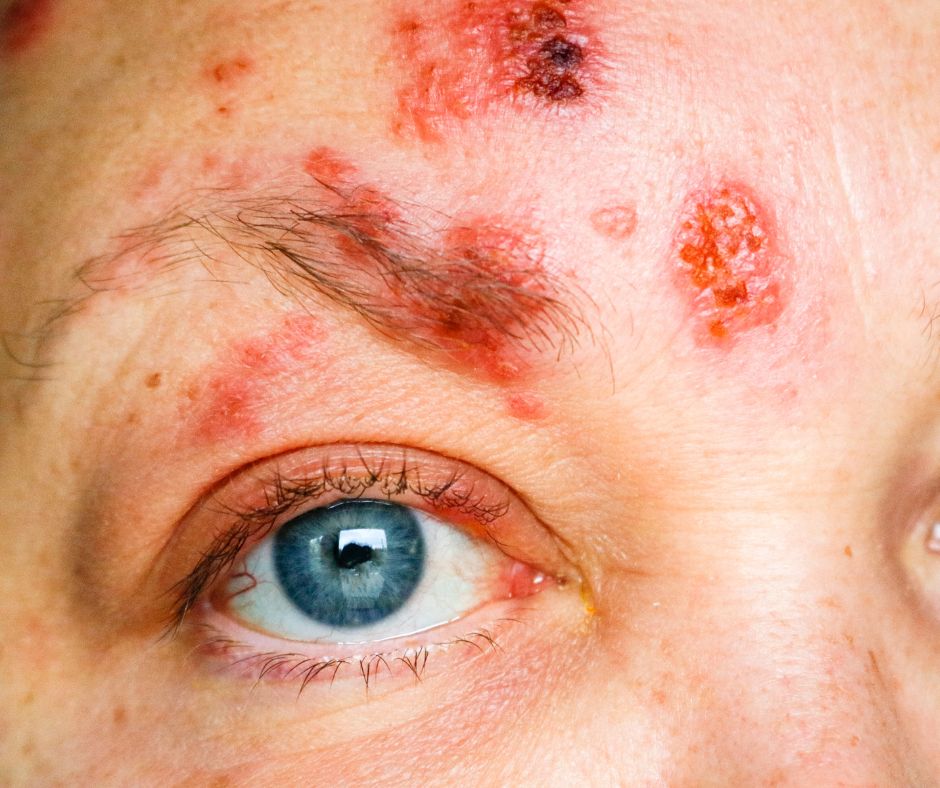
09 May Shingles In The Eyes: Symptoms, Diagnosis, And Complications
Did you know that up to 20% of people who develop shingles may experience eye-related complications? The effects of shingles extend beyond the skin, potentially affecting the eyes and vision. From inflammation to nerve damage, the virus responsible for shingles can pose serious risks to ocular health. Understanding shingles in the eyes is crucial in recognizing symptoms early and seeking appropriate medical care to prevent long-term consequences.
Shingles And Eye Involvement
Shingles, also known as herpes zoster, can affect the eyes when the virus reactivates in the ophthalmic branch of the trigeminal nerve. This reactivation leads to various eye complications, such as keratitis, uveitis, and conjunctivitis.
Shingles manifest with painful skin rashes around the eye or on the forehead, accompanied by symptoms like redness, swelling, and sometimes vision disturbances.
The reactivation of the varicella-zoster virus in the trigeminal nerve can lead to significant pain and discomfort around the eye region. The virus travels along the nerve fibers to reach the eye, causing inflammation and potentially affecting vision.
Symptoms Of Eye Shingles
Apart from painful rashes around the eye area, patients may also experience generalized shingles symptoms such as fever, fatigue, itching, burning, or sensitivity to light.
Severe eye symptoms of shingles may include redness and swelling around the eyelid. This inflammation can lead to discomfort and potential complications if left untreated.
Another crucial symptom to recognize is blurred vision, which could indicate eye involvement in shingles. This visual impairment may vary in intensity and duration, requiring immediate medical attention to prevent further complications.
Shingles Entering The Eyes
Shingles can enter the eyes when the varicella-zoster virus, responsible for both chickenpox and shingles, reactivates along the trigeminal nerve, affecting the ophthalmic branch. This nerve supplies sensation to the scalp, forehead, and front of the head, including the eyes.
When shingles affect the area around the eyes, it can lead to serious complications that extend beyond skin rashes. The proximity of shingles lesions to the eyes poses risks of various eye conditions and problems. These include inflammation of different parts of the eye, such as conjunctivitis (pink eye), keratitis (inflammation of the cornea), and uveitis (inflammation of the middle layer of the eye).
Moreover, shingles around the eyes can result in potential scarring on the cornea, leading to long-term issues with vision. If left untreated, severe cases may even cause permanent damage to vision due to complications like glaucoma or retinal necrosis. Seeking prompt medical attention is crucial to prevent these severe outcomes.
Diagnosing And Treating Eye Shingles
Eye shingles can be diagnosed through a comprehensive eye examination by an optometrist. Early treatment of eye shingles is crucial to prevent complications such as vision loss. Antiviral medications are commonly prescribed to reduce the severity and duration of the infection. These medications work by inhibiting the replication of the herpes zoster virus, helping to speed up recovery.
In addition to antiviral medications, using prescribed eye drops can help alleviate symptoms like itching and discomfort. These drops can also prevent further irritation caused by dryness. Applying cool compresses over the affected eye can provide relief from pain and reduce swelling. It is essential to follow your eye doctor’s instructions carefully when using these treatments.
Strategies To Prevent Shingles In The Eyes
Getting vaccinated is a highly effective strategy in preventing shingles. The shingles vaccine significantly reduces the risk of developing shingles.
Ensuring a strong immune system can help prevent shingles outbreaks. Eating a balanced diet, staying hydrated, exercising regularly, and getting enough sleep are crucial factors.
Direct contact with shingles blisters can spread the virus to individuals who have not had chickenpox or the vaccine. Avoiding contact helps prevent the transmission of the virus.
Maintaining good hygiene practices, such as regular handwashing, can reduce the risk of contracting the varicella-zoster virus responsible for shingles.
High stress levels can weaken the immune system, making individuals more susceptible to infections like shingles. Stress management techniques, such as meditation or yoga, can be beneficial.
Addressing Contagious Concerns
Considering its viral nature, shingles can be transmitted when a person comes into contact with the fluid-filled blisters of an infected individual. The virus can be passed on to those who have not had chickenpox or the vaccine, increasing the risk of developing shingles.
Moreover, individuals with weakened immune systems are more susceptible to contracting shingles. Therefore, it is essential for such individuals to take extra precautions and consider getting vaccinated to reduce the risk of developing this viral disease.
Detecting eye shingles early is key to preventing severe complications. Remember, your eyesight is precious, so don’t ignore any unusual symptoms. If you suspect eye shingles, seek medical attention promptly to receive appropriate treatment and minimize risks. Booking an appointment with an optometrist is the first step to diagnosing and treating shingles. To book an appointment at Dr D’Orio Eyecare, visit https://drdorioeyecare.com/book-appointment/ or call us at 416-656-2020 for our Toronto location, or 416-661-5555 for our North York location.


